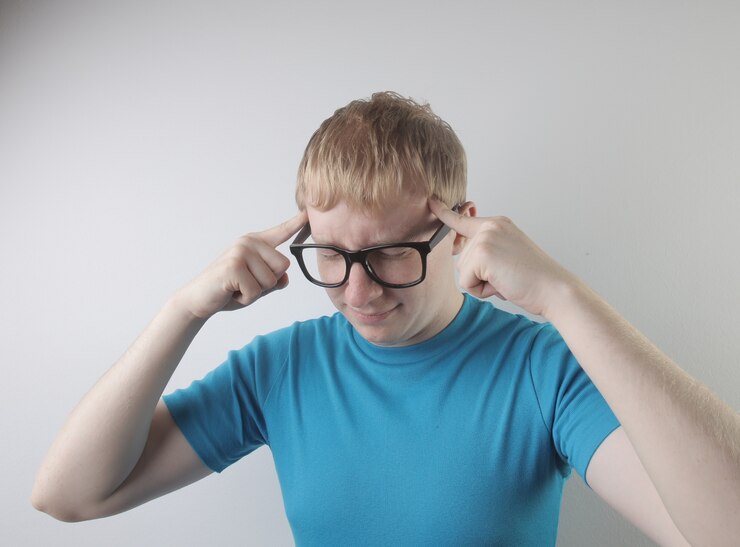1. Introduction to ADHD Glasses
What are ADHD Glasses?
ADHD glasses are a specialized form of eyewear designed to aid individuals with Attention Deficit Hyperactivity Disorder (ADHD) in managing their symptoms. These glasses are tailored to improve focus and reduce distractions by altering how the brain processes visual stimuli. ADHD glasses incorporate lenses with various technologies aimed at addressing the challenges faced by individuals with ADHD, such as difficulty concentrating, overstimulation, and sensitivity to light.
These glasses combine specific features like blue light filtering, color-tinted lenses, and other design elements that help to reduce visual noise and cognitive overload. They have gained popularity in recent years, especially as a non-invasive tool for people struggling with ADHD symptoms.
The Science Behind Their Functionality
The primary science behind ADHD glasses revolves around the way the brain responds to visual stimuli. People with ADHD often struggle to filter out distractions, which can lead to overstimulation. These glasses help by minimizing visual disturbances such as glare and blue light, which are known to contribute to focus issues. By using specific lens technologies, ADHD glasses aim to support cognitive function and attention span, making it easier for users to stay focused.
Who Can Benefit from Them?
ADHD glasses are beneficial for individuals of all ages diagnosed with ADHD, whether they are children, teenagers, or adults. These glasses are also useful for individuals who may not have a formal diagnosis but experience symptoms like difficulty focusing, excessive restlessness, and visual distractions. ADHD glasses can enhance focus in various environments, such as schools, workplaces, or home settings, making them an ideal option for anyone needing extra support with focus and concentration.
2. How ADHD Glasses Work
Filtering Blue Light and Visual Noise
ADHD glasses are designed to filter out harmful blue light and reduce visual noise. Blue light, which is emitted by screens and artificial lighting, has been shown to disrupt the body’s circadian rhythm and contribute to problems with sleep and concentration. By filtering out blue light, ADHD glasses reduce visual stress, making it easier for individuals to focus without becoming distracted by unnecessary stimuli. This helps minimize cognitive overload and supports sustained attention.
Additionally, the glasses reduce visual noise – the distracting background stimuli that can overwhelm individuals with ADHD. Visual noise can take the form of excessive patterns, glare, or bright colors, all of which can make it more difficult to focus. The lenses in ADHD glasses help to minimize these elements, allowing users to better process visual information and concentrate on tasks at hand.
Impact on Focus, Concentration, and Overstimulation
ADHD glasses work by regulating the intensity of visual stimuli, which can impact focus and concentration. The ability to block out distractions like bright lights, glare, and sharp contrasts helps users maintain attention on tasks for longer periods of time. People with ADHD often struggle with hyperactivity, leading them to become easily overstimulated by their surroundings. ADHD glasses can act as a tool to reduce overstimulation and promote calmness and concentration, which is vital for daily tasks such as studying, working, or engaging in social activities.
Comparison with Traditional Blue Light-Blocking Glasses
Traditional blue light-blocking glasses primarily aim to reduce digital eye strain caused by excessive screen time. While they can be helpful for people looking to protect their eyes from blue light, they do not necessarily address the unique challenges faced by individuals with ADHD. ADHD glasses go beyond blue light filtering; they also incorporate other technologies designed to improve focus and reduce distractions, such as specific lens colors and visual enhancements tailored for ADHD management. The key difference lies in the specialized lens technology and design focused on managing ADHD symptoms, not just protecting eye health.
3. Latest Innovations in ADHD Glasses (2025 Trends)
Smart ADHD Glasses with AI-Assisted Adjustments
In 2025, advancements in technology have led to the development of smart ADHD glasses, which are equipped with AI-assisted features. These glasses adapt to the wearer’s environment and adjust the lens properties in real-time. For example, they can automatically filter out more blue light when working on a screen or adjust the tint based on the level of visual distraction in the environment. AI-driven enhancements ensure that the glasses provide optimal support for focus, making them more personalized and effective in managing ADHD symptoms.
Prescription vs. Non-Prescription Options
ADHD glasses come in both prescription and non-prescription options, catering to individuals with different visual needs. Prescription glasses are designed for people who require vision correction, while non-prescription versions can still provide the benefits of ADHD symptom management without affecting vision. Both types offer the same features for focus enhancement and visual noise reduction, making them accessible to a wider audience, regardless of their existing visual requirements.
Adaptive Lenses for Screen Use and Daily Activities
Another recent innovation is the use of adaptive lenses in ADHD glasses. These lenses automatically adjust their tint based on the user’s environment and the activity they are engaged in. Whether working on a computer, reading a book, or interacting with others in a social setting, adaptive lenses can optimize visual comfort, reduce distractions, and support concentration. This technology ensures that individuals with ADHD can have a seamless experience across different settings without having to manually adjust their eyewear.
4. ADHD Glasses vs. Other Focus-Enhancing Tools
How They Compare with Noise-Canceling Headphones
Noise-canceling headphones are often used by individuals with ADHD to block out external distractions and improve focus. While these headphones are effective in reducing auditory stimuli, ADHD glasses address a different aspect of distraction: visual noise. When combined, these tools can work synergistically to create a more controlled and focused environment for individuals with ADHD. ADHD glasses tackle visual distractions, while noise-canceling headphones block out unwanted sounds, allowing the user to concentrate on their task more effectively.
Use Alongside Medication and Therapy
ADHD glasses can complement traditional treatments for ADHD, such as medication and therapy. While they are not a replacement for prescribed treatments, they can be a valuable addition to a broader ADHD management plan. ADHD glasses are non-invasive, offering a drug-free way to alleviate some of the cognitive challenges that come with ADHD, such as difficulty staying focused and managing overstimulation. Users who combine glasses with medication or therapy may experience improved results and greater symptom control.
Real-Life Case Studies and User Experiences
Many users have reported positive experiences with ADHD glasses, particularly when it comes to managing their daily tasks and improving focus. Case studies show that children who wear ADHD glasses are often able to stay on task for longer periods, experience less frustration, and have better academic outcomes. Adults with ADHD report increased productivity and better performance in both work and personal environments. These real-world applications demonstrate the effectiveness of ADHD glasses as a practical tool for managing ADHD symptoms.
5. Choosing the Right ADHD Glasses
Key Factors: Lens Type, Frame Style, and Technology
When selecting ADHD glasses, several factors should be considered to ensure that they meet individual needs. The lens type is crucial – it should provide blue light filtering and visual noise reduction. Frame style is another important consideration, as it should be comfortable and suited to the user’s preferences. Technology features, such as adaptive lenses or AI adjustments, can further enhance the glasses’ effectiveness. It’s important to choose a pair that offers the right combination of comfort, functionality, and aesthetic appeal.
Best Brands and Emerging Startups in 2025
Several brands and startups are leading the way in the development of ADHD glasses in 2025. Established eyewear companies have expanded their product lines to include ADHD-specific glasses, while emerging startups are pushing the boundaries of innovation with smart glasses and adaptive lenses. Popular brands now offering ADHD glasses include GAC, FocusFlex, and NeuroOptix, while new companies like BrainFocus and NeuroClear are quickly gaining attention for their cutting-edge designs.
Customization Options for Kids and Adults
ADHD glasses come in various designs and can be customized for both children and adults. Customization options include different frame styles, colors, and sizes to ensure that the glasses fit comfortably and appeal to the user’s tastes. For children, adjustable and durable frames are often recommended, while adults may opt for more professional styles suitable for office or public use.
6. Myths and Misconceptions About ADHD Glasses
Do They Really Help with ADHD Symptoms?
A common misconception is that ADHD glasses are a cure-all for ADHD symptoms. While they can significantly improve focus and reduce distractions, ADHD glasses are not a standalone solution. They should be used as part of a broader approach to ADHD management, which may include medication, therapy, and lifestyle changes. Scientific research continues to explore the full extent of their benefits, but early findings suggest that they offer real, tangible improvements for many individuals.
Scientific Evidence vs. Marketing Claims
It’s important to differentiate between the claims made by manufacturers and the actual scientific evidence supporting the effectiveness of ADHD glasses. Some products may make exaggerated claims about their ability to cure ADHD or radically change behavior. However, reputable brands are transparent about the benefits, focusing on improving visual comfort and concentration rather than offering a miracle cure.
Common Misunderstandings Debunked
One misunderstanding about ADHD glasses is that they are only effective for people with severe ADHD. In reality, individuals with mild to moderate symptoms can also experience significant benefits from wearing these glasses. Additionally, not all ADHD glasses are created equal – it’s important to research the specific features and technologies that best suit individual needs.
7. Future of ADHD Glasses and Vision Technology
AI-Driven Focus-Enhancing Eyewear
The future of ADHD glasses lies in AI-driven technology that can adjust the lenses in real-time based on the user’s environment and cognitive state. This could include smart features such as tracking attention levels and adjusting visual filters accordingly. As AI technology improves, ADHD glasses will become even more personalized, adaptive, and effective in enhancing focus.
Integration with VR and AR for ADHD Management
The integration of virtual reality (VR) and augmented reality (AR) with ADHD glasses is another exciting development. By combining visual enhancement with immersive environments, VR and AR technologies can provide ADHD patients with targeted cognitive training exercises, mindfulness techniques, and distraction-free settings. This combination of hardware and software could offer a powerful tool for ADHD management in the future.
How Technology is Evolving to Support Neurodivergent Individuals
The rapid evolution of technology is helping to support neurodivergent individuals, including those with ADHD, in ways that were once thought impossible. From AI-assisted glasses to VR environments, technology is increasingly being designed to meet the unique needs of individuals with ADHD, helping them navigate the world with greater ease and success.
8. Conclusion
Final Thoughts on ADHD Glasses
ADHD glasses are an innovative and promising tool for individuals struggling with focus, concentration, and overstimulation. As technology continues to advance, these glasses are becoming more effective and accessible, offering a valuable non-invasive alternative to traditional ADHD treatments. Whether used alone or in conjunction with other therapies, ADHD glasses can significantly improve daily functioning for many individuals.
Who Should Consider Using Them?
Anyone who experiences difficulty focusing, managing distractions, or feeling overstimulated may benefit from ADHD glasses. From children in school to adults in the workplace, ADHD glasses provide a practical and personalized solution for managing ADHD symptoms.
Encouraging Further Research and Innovation
As we move further into 2025, it is crucial to continue researching and innovating in the field of ADHD management. ADHD glasses are just one example of how technology can improve the lives of neurodivergent individuals. Continued investment in research and development will lead to even more effective solutions, ultimately helping people with ADHD lead more successful and fulfilling lives.



